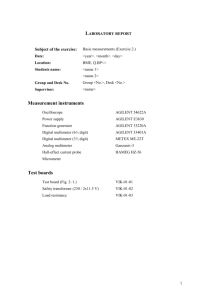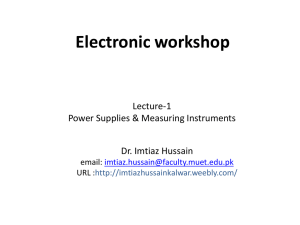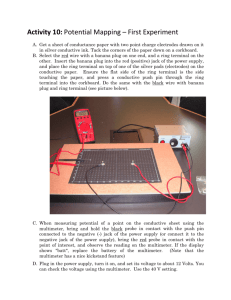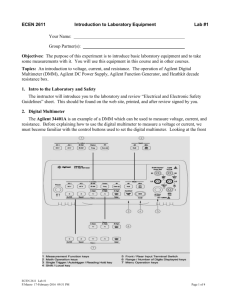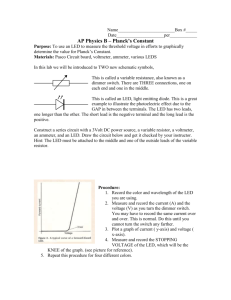LABORATORY 3 BASIC ERRORS IN MEASUREMENTS
advertisement
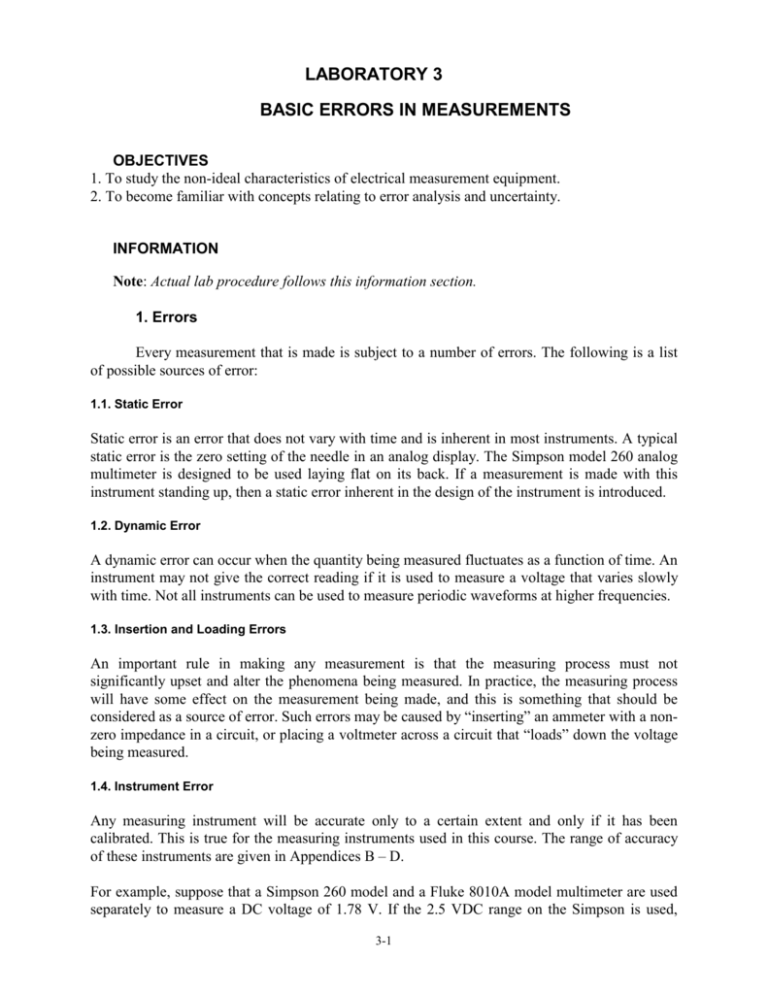
LABORATORY 3 BASIC ERRORS IN MEASUREMENTS OBJECTIVES 1. To study the non-ideal characteristics of electrical measurement equipment. 2. To become familiar with concepts relating to error analysis and uncertainty. INFORMATION Note: Actual lab procedure follows this information section. 1. Errors Every measurement that is made is subject to a number of errors. The following is a list of possible sources of error: 1.1. Static Error Static error is an error that does not vary with time and is inherent in most instruments. A typical static error is the zero setting of the needle in an analog display. The Simpson model 260 analog multimeter is designed to be used laying flat on its back. If a measurement is made with this instrument standing up, then a static error inherent in the design of the instrument is introduced. 1.2. Dynamic Error A dynamic error can occur when the quantity being measured fluctuates as a function of time. An instrument may not give the correct reading if it is used to measure a voltage that varies slowly with time. Not all instruments can be used to measure periodic waveforms at higher frequencies. 1.3. Insertion and Loading Errors An important rule in making any measurement is that the measuring process must not significantly upset and alter the phenomena being measured. In practice, the measuring process will have some effect on the measurement being made, and this is something that should be considered as a source of error. Such errors may be caused by “inserting” an ammeter with a nonzero impedance in a circuit, or placing a voltmeter across a circuit that “loads” down the voltage being measured. 1.4. Instrument Error Any measuring instrument will be accurate only to a certain extent and only if it has been calibrated. This is true for the measuring instruments used in this course. The range of accuracy of these instruments are given in Appendices B – D. For example, suppose that a Simpson 260 model and a Fluke 8010A model multimeter are used separately to measure a DC voltage of 1.78 V. If the 2.5 VDC range on the Simpson is used, 3-1 there will be an inherent error of 2% of full scale deflection (from Appendix B) or 0.05 V (2.5 V x 2%). The accuracy will be 1.78 ± 0.05 V. If the 2 VDC range of the Fluke is used, the error introduced will be 0.1% of the reading plus the last digit (from Appendix C). If the Fluke’s digital display shows 1.782 V, then the error due to the actual reading is 0.001782 V. The readout, however, cannot display all these digits and the error is rounded off to 0.002. An additional error is introduced in the last or least significant digit (LSD) of 1, giving a total error in the reading of 0.003. The recorded reading now becomes 1.782 ± 0.003 V. The error due to the last digit is 0.001 V because for the 2 V range, there are three digits after the decimal point in the meter’s display. 1.5. Human Error A human error is an error made by an observer when recording a measurement or by using an instrument incorrectly. Two types of human error are parallax reading error (caused by reading an instrument pointer from an angle) and interpolation error (made in “guessing” the correct value between two calibrated marks on the meter scale). 1.6. Theoretical Error Theoretical models are often used to determine the range of measurement that can be expected when measurements of phenomena are made. The actual phenomena, however, may be complex and the model used may be valid over a small limited range of values. This can result in a discrepency between theoretical and measured results that is not caused by any experimental error, but by the inadequacy of the theoretical model to describe the phenomena being measured. 1.7. Miscellaneous Error A miscellaneous error is an error that does not fit in the above catagories. An example of such an error is an error caused by taking measurements under different temperature conditions. 2. SIGNIFICANT FIGURES It is customary in measurement work to report a result with all the digits of which we are sure, and a final digit that is believed to be nearest to the true value. It is misleading and incorrect to give more than one doubtful figure, e.g. to put down a particular value for tenths of a unit when the number of units is not definitely known. For example, a measurement of "5.17 V" indicates that the voltage is known to better than one tenth of a volt and that the measurement of the hundredth of a volt is uncertain but is close to seven. Superfluous figures are sometimes allowed to accumulate in computations involving addition, substraction, multiplication or division, but the final answer must be rounded off if extra digits accumulate beyond the inherent limits of certainty of the original data. It is standard practice that if the digit to be discarded is less than 5, then it and any succeeding numbers are dropped; if the digit is 5 or greater, then the previous digit is increased by one and succeeding numbers are dropped. For example, if 67.238 were to be rounded to three significant digits, then it would rounded to 67.2; if 67.267 were to be rounded to three significant digits, then it would rounded to 67.3. Some examples of accumulation of superfluous figures and rounding off are given below. 3-2 Example 2.1 Suppose we have two resistances in series with values of R1 = 24.4 W and R2 = 0.516 W. The total series resistance (R1 + R2) is 24.916 W, but this value is meaningless since R1 has an accuracy of ± 0.1 W and the sum cannot be guaranteed to a one-tenth of an ohm. The sum should therefore be rounded to 24.9 W. Example 2.2 Suppose we wish to find the voltage drop across a resistor using Ohm's law and the values measured for resistance and current are 45.73 W and 2.56 A respectively. The voltage drop becomes V = IR = 117.0688 V. The resistance value is known to four significant figures and the current is known to three. This limits the number of significant figures that can be included in the answer since the answer cannot be known to greater accuracy than the least defined of the parameters. The correct procedure is therefore to round off the answer to three significant figures, i.e. to 117 V. 3. LIMITING ERRORS (GUARANTEED ACCURACY) Suppose the power dissipated in a 100 W, 2% resistor is to be determined using P = I2R where I = 4.0 A as measured on the 10 A range of an ammeter with a full scale deflection (fsd) accuracy of 1%. The manufacturer's specification of the tolerance on the value of resistance does not specify a standard deviation or probable error, but instead specifies that the error will be no greater than 2% (2.00 W in our example). Similarly, the manufacturer of the ammeter guarantees that the error in the current measurement will be no greater than 1% fsd (0.100 A). These are limiting errors in the sense that it is virtually certain that the errors will not exceed these limits. 4. PROPAGATION OF UNCERTAINTIES Suppose that in addition to calculating the power P we wish to calculate the limits within which the value of P can be guaranteed. The maximum value of P can be calculated using methods of partial differentiation by treating the uncertainty in each variable as a differential and the uncertainty in the derived result as a total differential. The total differential for a function w = f(x, y) is defined as dw = ¶w ¶w dx + dy ¶x ¶y Equation (3.1) where dx and dy are differentials in x and y respectively. If the uncertainties in P, I, and R can be expressed as dP = dw, dI = dx, and dR = dy, then the expression for the limit of uncertainty in P can be written as ¶P ¶P Equation (3.2) dR dP = dI + ¶I ¶R where absolute values are used to allow for the worst case where the effects of the uncertainties are additive. Since P = I2R, the partial derivatives are ¶P ¶ 2 = I R = 2 IR Equation (3.3) ¶I ¶I 3-3 ¶P ¶ 2 = I R = I2 ¶R ¶R Equation (3.4) If dI = 0.100 A and dR = 2.00 W, then the uncertainty in P is dP = (2 ´ 4.00 ´ 100.0)(0.10) + (4.00) 2 (2.00) = 80.0 + 32.0 = 112.0W Equation (3.5) If P = (4.00) 2 ´ (100.0) = 1600.0W , then the maximum percent error is (112/1600)= 7.00%. It should be noted that the actual error will be very likely less than the maximum error. The propagated uncertainty for P can also be calculated using relative errors. If ¶P ¶P Equation (3.6) dP = dI + dR = 2 IRdI + I 2dR ¶I ¶R then an expression for the relative uncertainty in power can be obtained by dividing both sides of the equation by P = I2R: dP dI dR Equation (3.7) =2 + P I R where dP/P, dI/I, and dR/R are the relative uncertainties in P, I, and R respectively. Again, the maximum percent error is 7.00%. PRE-LAB PREPARATION The lab preparation must be completed before coming to the lab. Show it to your TA for check at the beginning of the lab and get his/her signature in the Signature section of the Lab Measurements Sheet. The penalty for incomplete preparations is 20%. 1. [ 25 MARKS] Voltmeters a) Figure 3.1 shows an electrical circuit consisting of a dc voltage source V1, two resistors in series, R1 and R2, and a voltmeter VM connected to measure the voltage across R2. If V1 = 10.0 VDC, R1 = 470 kW ± 5% and R2 = 120 kW ± 5% and voltmeter VM is an ideal voltmeter. Calculate the expected reading of the meter (VM) , and record it in the column labeled “Calculated value” in Table 3.2 of the Lab Measurements Sheet. Calculate the uncertainty in VM due to the uncertainty of the given resistors. Show all of your calculations on a separate sheet of paper. b) Calculate the expected reading (VDIGITAL) when a practical digital multimeter set to measure dc voltage is used instead of an ideal meter for VM. Record your results in Table 3.2. Note that the multimeter, when used as a voltmeter, can be modelled as an ideal voltmeter in parallel with an internal input resistance(Rin) as shown in Figure 3.2. The value of the resistance is dependent on the scale setting used. Include the internal input resistance of the meter in your calculations. The values needed for this calculation can be found in Appendix C. Assume that you will use the Fluke multimeter in the lab when doing this calculation. 3-4 Calculate the instrument error associated with this reading, and enter the result in Table 3.2. Again, you will need to use Appendix C. R1 R1 470k 470k V1 10V V V1 R2 VM R2 120k V 10V Rin 120k VM COM Digital IDEAL COM Figure 3.1 Voltage measurement circuit Figure 3.2 Voltage measurement using a non-ideal meter c) Repeat part b) using a practical analog meter instead of a practical digital multimeter, i.e., calculate VANALOG. From Appendix B, assuming a fsd of 2.5 VDC, the sensitivity is 20,000 W/V. Hence, the input resistance is 2.5 V x 20,000 W/V = 50,000 W = 50 kW. 2. [ 25 MARKS] Ammeters a) Figure 3.3 shows an electrical circuit consisting of a dc voltage source V1, a resistor R and an ammeter AM connected in series. If R = 1.5 kW ± 5% and ammeter AM is an ideal ammeter, then calculate the expected reading of the meter for a DC source voltage V1 = 1.3 VDC. Record your results in the column labeled “Calculated value” in Table 3.3 of the Lab Measurements Sheet. Also calculate the uncertainty in the expected reading due to the uncertainty of the given resistor. Show your calculations on a separate sheet of paper. R1 1.5k A V1 AM 1.3V Com COM Figure 3.3 Current measurement circuit b) Re-calculate the current if a practical digital multimeter is used instead of an ideal meter as shown in Figure 3.4. Include the internal input resistance of the meter in your calculations. The values needed for this calculation can be found in Appendix C. Record your results in the column labeled “Calculated value” (ADIGITAL) in Table 3.3 of the Lab Measurements Sheet. 3-5 R1 1.5k A V1 Rin AD 1.3V com COM Figure 3.4 Current measurement using a non-ideal meter The internal resistance of meters in the ammeter mode can be calculated using the voltage drops at full scale deflection obtained from the instrument specifications. For example, the specification for the Simpson Model 260 meter shows a voltage drop of 280 mV fsd when the meter is set for the 0-100mA current range (see Appendix B). The ammeter resistance for this range is therefore: 280 ´ 10-3V = 2.8W RM = 100 ´10-3 A Equation (3.8) For the Fluke, the voltage drop is 0.3 V for all ranges other than 2000 mA (see Appendix C). Also, calculate and record in Table 3.3 the instrument error when using the digital meter. c) Repeat part b) but use an analog multimeter as an ammeter in the appropriate dc current measurement setting instead of the digital multimeter, i.e., calculate AANALOG. The values needed for this calculation can be found in Appendix B. EQUIPMENT 1. Digital multimeter (Fluke 8010A), BK PRECISION 2831B or BK PRECISION 2831C 2. Analog multimeter (Simpson 260/270) 3. Dc Power Supply 4. PROTO-BOARD (breadboard) 6. Resistors : 1.5 kW, 120 kW, 470 kW. PROCEDURE Note the following information before starting the lab: a) You will be using two different meters for this lab exercise: a digital multimeter and an analog multimeter that you will use as a voltmeter and an ammeter. b) When using either the digital and/or analog meter to do any measurement, set it to the range that will allow you to obtain the maximum digits or deflection. 3-6 1. Ohmmeters You are provided with three resistors to be used in this and other parts of the lab exercise. These have nominal values of 1.5 kW, 120 kW, and 470 kW. · Measure and record the value of each resistor in turn using the digital multimeter and fill the results in Table 3.1 of the Lab Measurements Sheet. · Answer the question in section 2 of the Lab Measurements Sheet. 2. Voltmeters a) Connect the circuit shown in Figure 3.1 using the PROTO-BOARD. Set V1 = 10.0 VDC using the digital multimeter. Replace the digital multimeter with the analog meter and use it to measure V1. Ask your TA to check your circuit and get his/her signature in the Signature section of the Lab Measurements Sheet. You will be penalized marks if your sheet is not initialed. b) Measure VM using the digital multimeter set to the range that will allow you to obtain the maximum digits after the decimal point. Record the readings in Table 3.2 (VDIGITAL). c) Repeat part b) using the Simpson analog multimeter set to the range that will allow you to obtain the maximum scale deflection. Pictures of Simpson 260 multimeter are shown on Figure 3.5. Record the reading in Table 3.2 (VANALOG). d) Answer the question in section 4 of the Lab Measurements Sheet. (a) Scale with deflection needle (b) Control panel Figure 3.5 Simpson 260/270 analog multimeter 3. Ammeters a) Connect the circuit shown in Figure 3.3 using the PROTO-BOARD breadboard. Set V1 = 1.3 VDC. Ask your TA to check your circuit and get his/her signature in the Signature section of the Lab Measurements Sheet. You will be penalized marks if your sheet is not initialed. b) Measure the current using the digital multimeter set to the range that will allow you to obtain the maximum digits after the decimal point. Record the readings in Table 3.3 (ADIGITAL). c) Repeat part b) using the analog multimeter set to the range that will allow you to obtain the maximum scale deflection. Record the readings in Table 3.3 (AANALOG). 3-7 LAB MEASUREMENTS SHEET Name _________________________ Student No_____________________ Workbench No_____ NOTE: Questions are related to observations, and must be answered as a part of the procedure of this experiment. Sections marked * are pre-lab preparation and must be completed BEFORE coming to the lab. 1. Table 3.1 Resistance measurements Resistor Nominal value *Uncertainty (kW) (kW) R1 1.5 kW R2 120 kW, R3 470 kW. 1 Measured value (kW) Calculate the “% Error” using the formula: % Error = % Error1 Nominal - Measured value ´100 Nominal value 2. Are the measured values within the tolerances specified by the manufacturer? 3. Table 3.2 Voltage measurements Voltage measurement *Calculated value (V) Instrument error (V) Measured value (V) V M (ideal) V DIGITAL V ANALOG 3-8 % Error from ideal2 % Error from calculated3 2 3 “% Error from ideal” is calculated using the formula: % Error = For “% Error from calculated” use the formula: % Error = Ideal - Measured value ´100 Ideal value Calculated - Measured value ´ 100 Calculated value 4. When measuring the voltage across a resistor, should the input resistance of the meter be lower or higher than the resistance of the resistor? 5. Table 3.3 Current measurements Current measurement *Calculated value (mA) *Instrument error (mA) Measured value (mA) AM A DIGITAL A ANALOG 4 Use formulas from section 3 of the Lab Measurements Sheet 3-9 %Error from ideal 4 %Error from calculated 4 6. When measuring the current through a resistor, should the input resistance be lower or higher than the resistance of the resistor? SIGNATURES TA name:________________________ To be completed by TA during the lab session. Pre-lab completed. Circuit in Figure 3.1 connected. Circuit in Figure 3.3 connected. Data collected, questions attempted, lab submitted. MARKS To be completed by TA after the lab session. Granted Marks Max. Marks 50 50 100 Task Pre-lab preparation Data collection and answers Total 3-10

